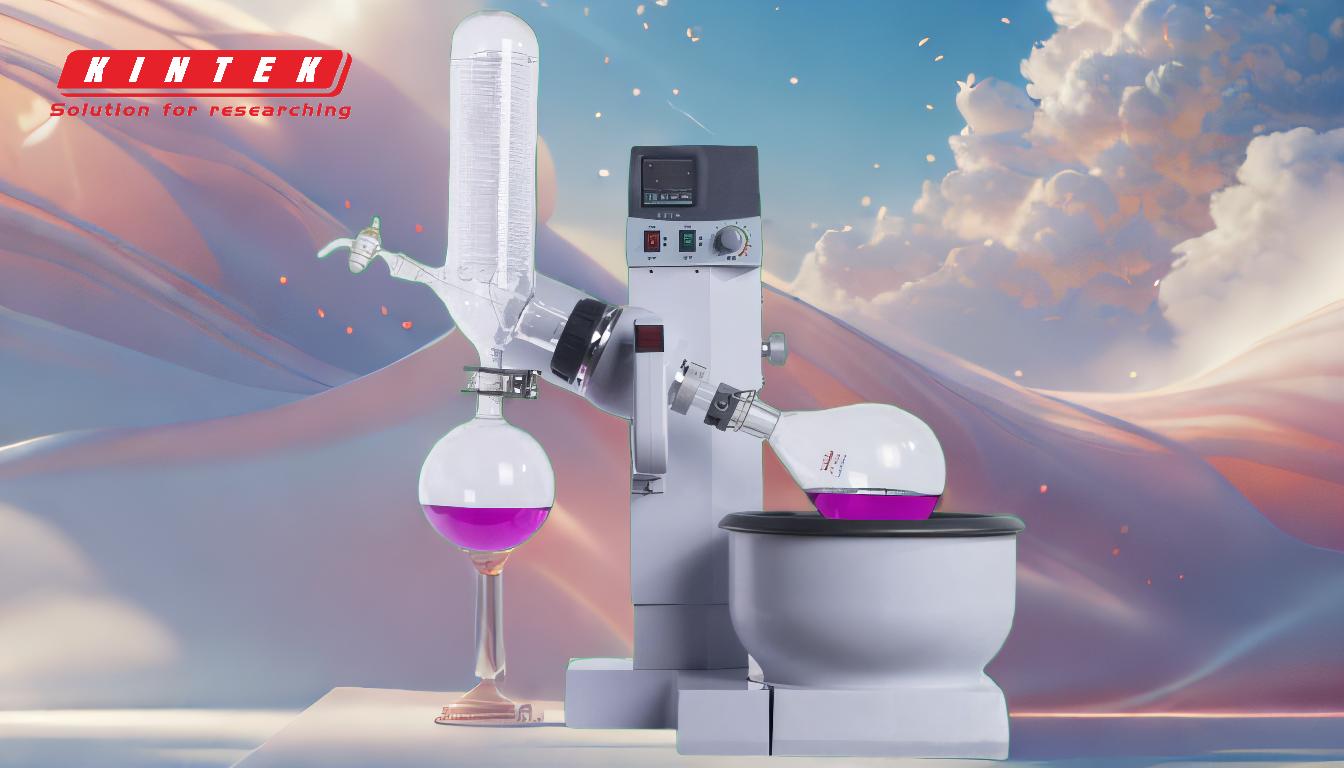A rotary evaporator is a sophisticated laboratory instrument designed for the efficient and gentle removal of solvents from samples through evaporation. Its construction is carefully engineered to ensure optimal performance, safety, and ease of use. The device consists of several key components, including a rotating flask, a heating bath, a condenser, a vacuum pump, and a receiving flask. These parts work together to create a controlled environment where solvents can evaporate at lower temperatures due to reduced pressure, condense back into liquid form, and be collected separately from the sample. The materials used, such as stainless steel and aluminum alloy, ensure durability and reliability. Below is a detailed breakdown of the construction and functionality of a rotary evaporator.
Key Points Explained:

-
Rotating Flask
- The rotating flask is a round-bottomed glass flask that holds the sample mixture.
- It is connected to the rotary motor, which rotates the flask to increase the surface area of the liquid, promoting even mixing and faster evaporation.
- Rotation also helps prevent bumping (sudden boiling or splashing) of the sample, which could lead to contamination or loss of material.
- The flask is typically made of high-quality borosilicate glass to withstand thermal stress and chemical corrosion.
-
Heating Bath
- The heating bath, often a water bath, is used to regulate the temperature of the sample in the rotating flask.
- It is temperature-controlled to ensure precise heating, which is essential for evaporating solvents without degrading heat-sensitive samples.
- The bath is usually made of stainless steel or aluminum alloy for durability and resistance to corrosion.
-
Condenser
- The condenser is a chilled component that cools and recondenses the evaporated solvent vapors back into liquid form.
- It is typically connected to a coolant source, such as a recirculating chiller, to maintain a low temperature.
- The condenser design often includes coils or a jacket to maximize the surface area for efficient cooling.
- The condensed solvent is collected in a receiving flask for further use or disposal.
-
Vacuum Pump
- The vacuum pump is a critical component that reduces the pressure inside the system, lowering the boiling point of the solvent.
- This allows for evaporation to occur at lower temperatures, minimizing the risk of thermal degradation of the sample.
- The pump is connected to the condenser via vacuum tubing, creating a closed system that maintains the desired pressure.
-
Receiving Flask
- The receiving flask collects the condensed solvent from the condenser.
- It is typically made of glass and designed to be easily removable for emptying or replacement.
- The flask is positioned below the condenser to allow gravity to assist in the collection process.
-
Bump Trap (Optional)
- A bump trap is sometimes included to prevent splashing or foaming of the sample during evaporation.
- It acts as a barrier between the rotating flask and the condenser, ensuring that only vapor passes through.
- This component is particularly useful when working with volatile or foamy samples.
-
Solvent Trap (Optional)
- A solvent trap is used to capture any solvent vapors that might escape the system, preventing contamination of the vacuum pump or the environment.
- It is typically placed between the condenser and the vacuum pump.
-
Structural Materials
- The main framework of the rotary evaporator is constructed from stainless steel and aluminum alloy, providing a combination of strength, durability, and aesthetic appeal.
- These materials are resistant to corrosion and can withstand the mechanical stresses of continuous operation.
-
Additional Features
- Modern rotary evaporators may include digital controls for precise adjustment of rotation speed, temperature, and vacuum pressure.
- Safety features, such as automatic shut-off mechanisms and over-temperature protection, are often incorporated to enhance user safety.
By integrating these components, a rotary evaporator provides a reliable and efficient solution for solvent removal in various laboratory applications, including chemistry, pharmaceuticals, and food science. Its design ensures gentle handling of samples while maintaining high levels of precision and control.
Summary Table:
| Component | Function | Material/Features |
|---|---|---|
| Rotating Flask | Holds sample; rotates to increase surface area for faster evaporation. | Borosilicate glass for thermal and chemical resistance. |
| Heating Bath | Regulates sample temperature for precise evaporation. | Stainless steel or aluminum alloy; temperature-controlled. |
| Condenser | Cools and recondenses solvent vapors into liquid. | Coils or jacket design; connected to a coolant source. |
| Vacuum Pump | Reduces system pressure to lower solvent boiling point. | Maintains closed system; minimizes thermal degradation. |
| Receiving Flask | Collects condensed solvent for disposal or reuse. | Glass; removable for easy handling. |
| Bump Trap (Optional) | Prevents sample splashing during evaporation. | Acts as a barrier between flask and condenser. |
| Solvent Trap (Optional) | Captures escaping solvent vapors to protect pump and environment. | Placed between condenser and vacuum pump. |
| Structural Materials | Provides durability and corrosion resistance. | Stainless steel and aluminum alloy. |
| Additional Features | Enhances precision and safety. | Digital controls, automatic shut-off, and over-temperature protection. |
Need a reliable rotary evaporator for your lab? Contact us today to find the perfect solution!










